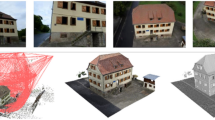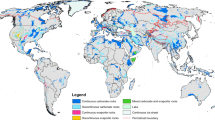Abstract
We have developed an OWL ontology for the geologic timescale, derived from a Unified Modeling Language (UML) model that formalized the practice of the International Commission for Stratigraphy (ICS) (Cox and Richard 2005). The UML model followed the ISO/TC 211 modeling conventions, and was the basis for an XML implementation that was integrated into GeoSciML 3.0. The OWL ontology is derived using rules for generating OWL ontologies from ISO-conformant UML models, as provided in a (draft) standard from ISO/TC 211. The basic ontology is also aligned with SKOS to allow multilingual labels, and to enable delivery through a standard vocabulary interface. All versions of the International Stratigraphic Chart from 2004 to 2014 have been encoded using the ontology. Following ICS practice, the elements of the timescale retain the same identifiers across the multiple versions, though the information describing each geochronologic unit evolves with the versions of the timescale. The timescales are published through multiple web interfaces and APIs.







Similar content being viewed by others
Notes
See http://resource.geosciml.org/ontology/timescale/rank which includes Super-Eon, Eon, Era, Period, Sub-Period, Epoch, Age.
References
Beckett D, Berners-Lee T, Prud’hommeaux E, Carothers G (2014) RDF 1.1 Turtle. World Wide Web Consortium. http://www.w3.org/TR/2014/REC-turtle-20140225/. Accessed 15 May 2014
Berrueta D, Phipps J (2008) Best Practice Recipes for Publishing RDF Vocabularies. World Wide Web Consortium. http://www.w3.org/TR/swbp-vocab-pub/. Accessed 28 February 2014
Bizer C, Lehmann J, Kobilarov G et al (2009) DBpedia - a crystallization point for the Web of data. Web Semant 7:154–165. doi:10.1016/j.websem.2009.07.002
Cohen KM, Finney SC, Gibbard PL et al (2013) The ICS international chronostratigraphic chart. Episodes 36:199–204
Cox SJD (2013) An explicit OWL representation of ISO/OGC Observations and Measurements. In: Corcho O, Henson C, Barnaghi P (eds) Proc. 6th Int. Work. Semant. Sens. Networks co-located with 12th Int. Semant. Web Conf. (ISWC 2013). Sun SITE Central Europe, Sydney, Australia, October 22nd, 2013., pp 1–18. http://ceur-ws.org/Vol-1063/paper1.pdf. Accessed 28 February 2014
Cox SJD, Richard SM (2005) A formal model for the geologic time scale and global stratotype section and point, compatible with geospatial information transfer standards. Geosphere 1:119. doi:10.1130/GES00022.1
Cox SJD, Richard SM (2014) RDF representation of International Chronostratigraphic Chart (Geologic Timescale). doi: 10.4225/08/537452F354E36
Cox SJD, Yu J, Rankine T (2014) A Linked Data API for SKOS vocabularies. Semant. Web J. submitted:
Fils D, Cervato C, Reed J et al (2009) CHRONOS architecture: experiences with an open-source services-oriented architecture for geoinformatics. Comput Geosci 35:774–782. doi:10.1016/j.cageo.2008.02.035
Gradstein FM, Ogg JG, Smith AG (2005) Geologic time scale 2004. Cambridge University Press, Cambridge
Hobbs JR, Pan F (2006) Time Ontology in OWL. World Wide Web Consortium. http://www.w3.org/TR/owl-time/. Accessed 28 February 2014
ISO/IEC (2005) ISO/IEC 19501:2005 - Information technology -- Open Distributed Processing -- Unified Modeling Language (UML) Version 1.4.2. International Organization for Standardization, Geneva
ISO/TC-211 (2002) ISO 19108:2002 - Geographic information -- Temporal schema. International Organization for Standardization, Geneva
ISO/TC-211 (2005a) ISO/TS 19103:2005 - Geographic information -- Conceptual schema language. International Organization for Standardization, Geneva
ISO/TC-211 (2005b) ISO 19109:2005 - Geographic information -- Rules for application schema. International Organization for Standardization, Geneva
ISO/TC-211 (2011) ISO 19156:2011 - Geographic information -- Observations and measurements. International Organization for Standardization, Geneva
ISO/TC-211 (2013) ISO/DIS 19109:2013 - Geographic information -- Rules for application schema. International Organization for Standardization, Geneva
ISO/TC-211 (2014a) ISO/DIS 19150-2:2014 - Geographic information -- Ontology -- Part 2: Rules for developing ontologies in the Web Ontology Language (OWL). International Organization for Standardization, Geneva
ISO/TC-211 (2014b) ISO/DIS 19103 - Geographic information -- Conceptual schema language. International Organization for Standardization, Geneva
Ma X, Fox P (2013) Recent progress on geologic time ontologies and considerations for future works. Earth Sci Informa 6:31–46. doi:10.1007/s12145-013-0110-x
Ma X, Carranza EJM, Wu C et al (2011) A SKOS-based multilingual thesaurus of geological time scale for interoperability of online geological maps. Comput Geosci 37:1602–1615. doi:10.1016/j.cageo.2011.02.011
Ma X, Carranza EJM, Wu C, van der Meer FD (2012) Ontology-aided annotation, visualization, and generalization of geological time-scale information from online geological map services. Comput Geosci 40:107–119. doi:10.1016/j.cageo.2011.07.018
Miles A, Bechhofer S (2009) SKOS Simple Knowledge Organization System Reference. World Wide Web Consortium. http://www.w3.org/TR/skos-reference/. Accessed 28 February 2014
Murphy M, Salvador A (1994) International Stratigraphic Guide - Abridged Edition. International Commission for Stratigraphy and Geological Society of America
Object Management Group (2009) Ontology Definition Metamodel - Version 1.0. Object Management Group, Needham, Mass. USA. http://www.omg.org/spec/ODM/1.0/. Accessed 28 February 2014
Perrin M, Mastella LS, Morel O, Lorenzatti A (2011) Geological time formalization: an improved formal model for describing time successions and their correlation. Earth Sci Informa 4:81–96. doi:10.1007/s12145-011-0080-9
Raskin RG, Pan MJ (2005) Knowledge representation in the semantic web for Earth and environmental terminology (SWEET). Comput Geosci 31:1119–1125. doi:10.1016/j.cageo.2004.12.004
Remane J, Bassett MG, Cowie JW et al (1996) Revised guidelines for the establishment of global chronostratigraphic standards by the international commission on stratigraphy (ICS). Episodes 19:77–81
Richard SM, CGI-Interoperability-Working-Group (2007) GeoSciML – A GML Application for Geoscience Information Interchange. In: Soller D (ed) Digit. Mapp. Tech.’06 — Work. Proceedings, USGS Open File Rep. 2007-1285. United States Geological Survey, Columbus, OH., pp 47–59. http://pubs.usgs.gov/of/2007/1285/pdf/Richard.pdf. Accessed 28 February 2014
Shergold JH, Cooper RA (2005) The Cambrian period. A geol. Time scale 2004. Cambridge University Press, Cambridge
W3C OWL Working Group (2012) OWL 2 Web Ontology Language Document Overview (Second Edition). World Wide Web Consortium. http://www.w3.org/TR/owl2-overview/. Accessed 28 February 2014
Acknowledgments
Parts of this work were funded by AuScope under the Australian Government’s National Collaborative Research Infrastructure Strategy. Terry Rankine and Jacqui Githaiga (CSIRO), and Stuart Williams (Epimorphics) assisted with the SISSvoc interface implementation. Doug Fils (ODP), Marshall Ma (RPI), Jonathan Yu (CSIRO), and Stephan Zednik (RPI), provided useful comments on the use and publication of RDF/OWL. Jim Ogg and Felix Gradstein of ICS provided some advice about the timescale structure. Guillaume Duclaux and Jonathan Yu (CSIRO) helped clarify some aspects of the paper in review. SJDC would like to pay tribute to the late W.B. Harland, who introduced the challenges of formalizing stratigraphy and the timescale in the undergraduate curriculum at Cambridge.
Author information
Authors and Affiliations
Corresponding author
Additional information
Communicated by: H. A. Babaie
Published in the Special Issue Semantic eScience with Guest Editors Dr. Xiaogang Ma, Dr. Peter Fox, Dr. Thomas Narock and Dr. Brian Wilson.
Rights and permissions
About this article
Cite this article
Cox, S.J.D., Richard, S.M. A geologic timescale ontology and service. Earth Sci Inform 8, 5–19 (2015). https://doi.org/10.1007/s12145-014-0170-6
Received:
Accepted:
Published:
Issue Date:
DOI: https://doi.org/10.1007/s12145-014-0170-6




